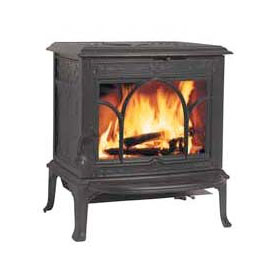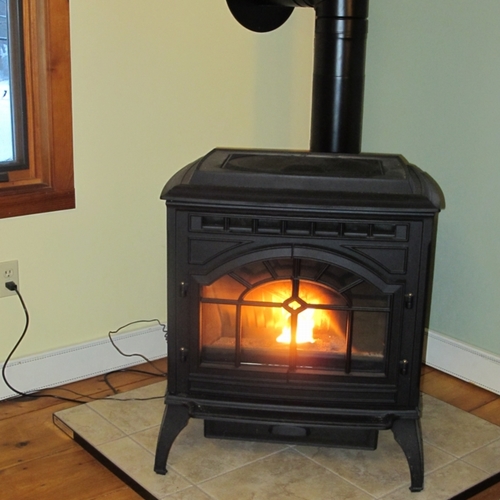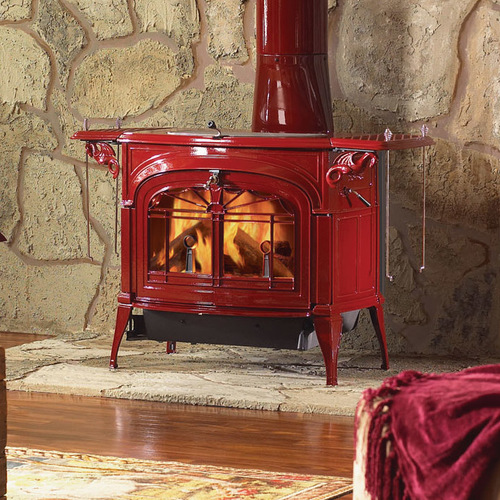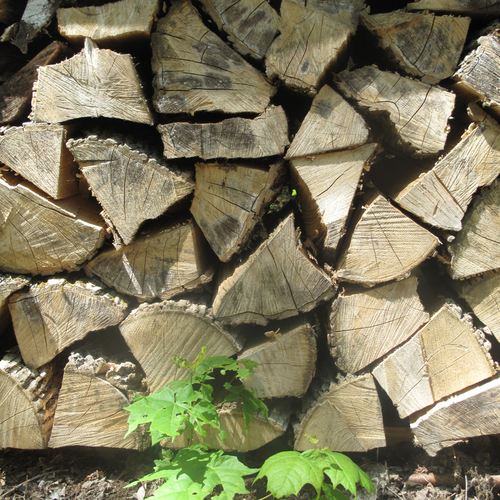
In the 27 years that I’ve owned my house in West Dummerston, Vermont, I’ve always used wood heat to some extent. But my commitment to it has ebbed and flowed. For about the first 15 years, I heated the house almost exclusively with wood. Built in 1785, the house had electric heat when I bought it, but with my work focused on energy efficiency and alternative energy sources, I couldn’t bring myself to use electricity for heating, because so much energy is wasted during power generation.
A Vermont Castings Resolute wood stove was one of my first purchases when I bought the house in 1981. To save money, I picked up the stove at Vermont Castings’ factory in Randolph in my little Datsun pickup. I also tried to save money by installing it myself with galvanized stovepipe going up through the old, unlined chimney. (Not too many years later, after that stovepipe began rusting out, I had Friends of the Sun do a proper installation with stainless steel.)
My experience with wood heat is probably not too different from that of a lot of people around here. For the first four or five years, I cut, hauled, split, and stacked all the wood myself, proving the old adage that burning wood warms you at least three or four times. I went through about four cords per year, so it was a lot of work. Though we had a through-the-wall venting gas space heater in our bedroom that we occasionally used, and though we kept the electric heat as back-up and for when we were going out of town (leaving the thermostats at 40 or 45 degrees), I’m guessing that wood provided about 90% of our heat.
After enough years of cutting and hauling wood myself, I started having log-length wood delivered by the truckload, and I would cut, split, and stack it myself. I did that for a few years, then shifted to getting our wood delivered already cut and split, leaving only the stacking for us. Eventually, at my wife’s gentle urging and tired of having to stoke the wood stove at 3 am, we bit the bullet and installed a central oil heating system—and dramatically reduced our use of wood for the next eight or ten years. In the last few years—and especially with last year’s jump in heating oil prices—we’ve gone back to burning wood for a significant portion of our heat. (And in our garage apartment we recently installed a pellet stove, but I’ll cover that in another column.)
Despite greatly enjoying sitting in front of a warm stove (where I’m sitting as I write this), I have reservations about burning wood. Of all our common fuels, wood produces the most pollution—especially the particulates we see as smoke. Byproducts of wood burning also include: carbon monoxide; nitrogen oxides (NOx); sulfur dioxide; hydrochloric acid; formaldehyde; and polycyclic aromatic hydrocarbons (PAHs), which are carcinogenic. The more smoke you see coming out of a chimney, the more particulate pollution is being generated.
In general, older wood stoves pollute a lot more than newer models. Pollution from wood stoves is measured in grams per hour. In the early 1980s, many wood stoves were producing 40 to 60 grams of pollution per hour. To address this, the U.S. Environmental Protection Agency (EPA) stepped in and, in 1988, issued standards for pollution emissions from wood stoves. EPA-certified stoves can emit no more than 7.5 grams per hour (under standard test conditions) for non-catalytic wood stoves and no more than 4.1 grams per hour for catalytic wood stoves. (Catalytic stoves have a coated ceramic honeycomb chamber that results in more complete, cleaner combustion.) Requiring wood stoves to be EPA-certified cleaned up wood burning dramatically.
When we started relying on wood heat more actively a few years ago, we sold our old, first-generation Resolute and bought a Norwegian (non-catalytic) Jotul wood stove, which is much more efficient and cleaner-burning. If you are looking for a wood stove, avoid the temptation to buy an older, used, uncertified model, because it will burn less efficiently and pollute more. (Next week, we’ll look at techniques for burning wood as efficiently and cleanly as possible.)
Along with producing these various pollutants, burning wood also gives off the greenhouse gas carbon dioxide. (Water vapor and carbon dioxide are the primary combustion products from wood burning.) However, if the wood is produced sustainably (meaning that new trees replace those that are cut—which is typical in New England woodlots), wood is actually a “carbon-neutral” fuel. That’s because the process of photosynthesis pulls carbon dioxide out of atmosphere and stores that carbon in the tree’s biomass. When the tree is cut down, some of that biomass (stored carbon) remains in the ground as roots or is left on the forest floor as slag. Again, assuming sustainable forest management, more carbon is “sequestered” in growing trees than is released when the firewood from those trees is burned.
Over the next few weeks, I’ll address various forms of wood burning, highlighting pros and cons and offering tips for cleaner, more efficient operation.
Weekly Newsletter
Get building science and energy efficiency advice, plus special offers, in your inbox.















0 Comments
Log in or create an account to post a comment.
Sign up Log in